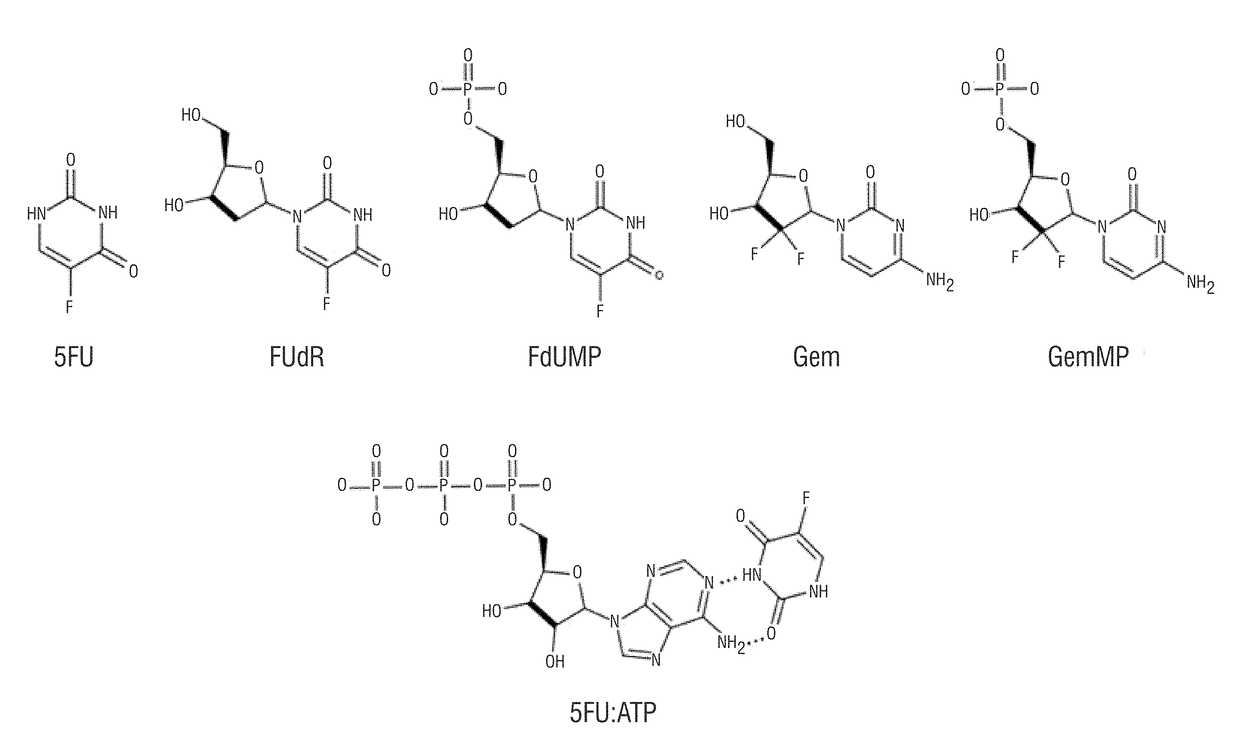Encapsulation and high loading efficiency of phosphorylated drug and imaging agents in nanoparticles
a phosphorylated drug and imaging agent technology, applied in the direction of capsule delivery, microcapsules, drug compositions, etc., can solve the problems of nucleotide pool imbalance, inhibition of dna synthesis, and misincorporation of nucleotides into dna, so as to increase the capacity to inactivate cancer cell proliferation, high loading efficiency of active phosphorylated drugs, and the effect of increasing efficiency
- Summary
- Abstract
- Description
- Claims
- Application Information
AI Technical Summary
Benefits of technology
Problems solved by technology
Method used
Image
Examples
example 1
Encapsulation Efficiencies of CPSNPs
[0055]The encapsulation efficiencies (EE) in Table 1 was experimentally determined by LC-MS / MS for 5FU, 5FU:ATP, FUdR, FdUMP, Gem, and GemMP, as drawn in FIG. 2 1. The EE is defined by the following equation,
mol%EE=mfmi×100
where m was the total drug content in moles and mf was the moles encapsulated as assessed by LC-MS / MS. Particles were diluted in 10% methanol with 0.1% formic acid and 5-CU was spiked in as an internal standard. Chromatography was done on a 2.1 mm×10 cm HSS T3 or C18 CSH column (Waters) on a Waters I-class FTN chromatography system with the column temperature at 40° C. Mobile phase A was water with 5 mM ammonium acetate and B was methanol. The flow rate was 0.5 mL / min and the chromatography consisted of holding at 7.5% B for 1 min, increasing to 95% B over 0.5 min, holding at 95% B for 0.5 min before equilibration to starting conditions. Eluate was analyzed by an inline Waters TQ-S mass spectrometer. The capillary was set at 1.0...
example 2
CPSNP Preparation
[0064]Reagents to perform the synthesis outlined in FIG. 1 include the HPLC stationary phase, which are solid glass microspheres ˜200 μM in diameter (Spheriglass A-Glass 1922, Potters Industries) soaked in purified water for 48 h and thoroughly rinsed with 10−3 M HCl (Sigma-Aldrich) and 10−3M NaOH (J. T. Baker) solutions before use. The stationary phase was wet-packed in a 5 cm long×⅜″ OD, ¼″ ID polycarbonate tube (McMaster-Carr). General chemicals include Igepal CO-520 (Rhodia Chemical Co.), cyclohexane (Alfa Aesar), 5-fluorouracil (SFU, ≧99%, Sigma-Aldrich), 5-fluoro-2′-deoxyurdine (FUdR, >98%, Tocris), 5-fluoro-2′-deoxyuridine-5′-monophosphate (FdUMP, ˜85-91%, Sigma-Aldrich), adenosine 5′-triphosphate disodium salt hydrate (ATP, 99%, Sigma-Aldrich), gemcitabine hydrochloride (Gem, ≧99%, Sigma-Aldrich), gemcitabine monophosphate formate salt (GemMP, 95%, TRC Canada) calcium chloride dihydrate (CaCl2, ≧99%, Sigma-Aldrich), sodium hydrogen phosphate (Na2HPO4, ≧99%, ...
example 3
In Vitro Evaluation of Free Drug and CPSNP Encapsulated FdUMP
[0073]The use of nanocarriers to deliver chemotherapeutic drugs can reduce toxic side-effects, increase efficacy, and obviate the drawbacks of poorly soluble drugs. These studies investigated whether CPSNPs can encapsulate FdUMP and deliver the active drug to cancer cells at an adequate dose to block tumor cell proliferation. While others have reported that polymeric FdUMP has efficacy against other cancers,42 the effect of FdUMP on pancreatic cancer cells, which are more inherently resistant to chemotherapeutic drugs, had not been shown. Initial studies therefore focused on the effect of free 5FU and FdUMP on the proliferation of the cultured human pancreatic cancer cell lines, Bx-PC3 and PANC-1 as shown in FIG. 5. BxPC-3 has been shown to be more sensitive to 5FU and gemcitabine, while PANC-1 is more resistant to both drugs.54,55 Referring to FIG. 5, in vitro proliferation of human pancreatic cancer cell lines BxPC-3 and...
PUM
| Property | Measurement | Unit |
|---|---|---|
| Diameter | aaaaa | aaaaa |
| Diameter | aaaaa | aaaaa |
| Fraction | aaaaa | aaaaa |
Abstract
Description
Claims
Application Information
 Login to View More
Login to View More - R&D
- Intellectual Property
- Life Sciences
- Materials
- Tech Scout
- Unparalleled Data Quality
- Higher Quality Content
- 60% Fewer Hallucinations
Browse by: Latest US Patents, China's latest patents, Technical Efficacy Thesaurus, Application Domain, Technology Topic, Popular Technical Reports.
© 2025 PatSnap. All rights reserved.Legal|Privacy policy|Modern Slavery Act Transparency Statement|Sitemap|About US| Contact US: help@patsnap.com



